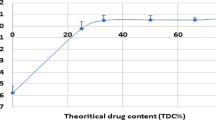Abstract
Purpose. Novel porous silicon microparticles were fabricated and loaded with fluorescein isothiocyanate (FITC)-insulin, a model hydrophilic pharmacologically active protein, along with varied doses of sodium laurate (C12), a well-known permeation enhancer.
Methods. Particle and liquid formulations were compared as a function of apical to basolateral flux of FITC-insulin across differentiated human intestinal Caco-2 cell monolayers grown on Transwell® inserts.
Results. The flux of FITC-insulin from silicon particles across cell monolayers was nearly 10-fold higher compared with liquid formulations with permeation enhancer and approximately 50-fold compared with liquid formulations without enhancer. By increasing C12 dose per particle with a concomitant decrease in total particles added per monolayer, the percent of FITC-insulin transport resulted in a linear increase up to 25% monolayer coverage.
Conclusions. Although maintaining monolayer integrity and transepithelial electrical resistance, maximum drug transport (20%/h) was achieved with 0.337 μg C12 dose per particle, and total particle loading at 25% monolayer coverage.
Similar content being viewed by others
REFERENCES
E. K. Anderberg, T. Lindmark, and P. Artursson. Sodium caprate elicits dilatations in human intestinal tight junctions and enhances drug absorption by the paracellular route. Pharm. Res. 10:857-864 (1993).
Y. Quan, K. Hattori, E. Lundborg, T. Fujita, M. Murakami, S. Muranishi, and A. Yamamoto. Effectiveness and toxicity screening of various absorption enhancers using Caco-2 cell monolayers. Biol. Pharm. Bull. 21:615-620 (1998).
M. Tomita, M. Shiga, M. Hayashi, and S. Awazu. Enhancement of colonic drug absorption by the paracellular permeation route. Pharm. Res. 5:341-346 (1988).
M. Hayashi, T. Sakai, Y. Hasegawa, T. Nishikawahara, H. Tomioka, A. Iida, N. Shimizu, M. Tomita, and S. Awazu. Physiological mechanism for enhancement of paracellular drug transport. J. Control. Release 62:141-148 (1999).
T. Lindmark, T. Nikkila, and P. Artursson. Mechanisms of absorption enhancement by medium chain fatty acids in intestinal epithelial Caco-2 cell monolayers. J. Pharmacol. Exp. Ther. 275:958-964 (1995).
M. Sakai, T. Imai, H. Ohtake, H. Azuma, and M. Otagiri. Effects of absorption enhancers on cytoskeletal actin filaments in Caco-2 cell monolayers. Life Sci. 63:45-54 (1998).
M. Tomita, M. Hayashi, and S. Awazu. Absorption-enhancing mechanism of sodium caprate and decanoylcarnitine in Caco-2 cells. J. Pharmacol. Exp. Ther. 272:739-743 (1995).
A. C. Chao, J. V. Nguyen, M. Broughall, A. Griffin, J. A. Fix, and P. E. Daddona. In vitro and in vivo evaluation of effects of sodium caprate on enteral peptide absorption and on mucosal morphology. Int. J. Pharm. 191:15-24 (1999).
M. Sakai, T. Imai, H. Ohtake, and M. Otagiri. Cytotoxicity of absorption enhancers in Caco-2 cell monolayers. J. Pharm. Pharmacol. 50:1101-1108 (1998).
J. D. Soderholm, H. Oman, L. Blomquist, J. Veen, T. Lindmark, and G. Olaison. Reversible increase in tight junction permeability to macromolecules in rat ileal mucosa in vitro by sodium caprate, a constituent of milk fat. Dig. Dis. Sci. 43:1547-1552 (1998).
I. J. Hidalgo, T. J. Raub, and R. T. Borchardt. Characterization of the human colon carcinoma cell line (Caco-2) as a model system for intestinal epithelial permeability. Gastroenterology 96:736-749 (1989).
S. Shih, C. Tsai, K.-H. Li, K. H. Jung, J. C. Campbell, and D. L. Kwong. Control of porous Si photoluminescence through dry oxidation. Appl Phys Lett. 60:633-635 (1992).
L. T. Canham (ed.), Properties of Porous Silicon, IEE, Stevenage, United Kingdom, 1997.
P. W. Swaan, K. M. Hillgren, F. C. Szoka Jr., and S. Øie. Enhanced transepithelial transport of peptides by conjugation to cholic acid. Bioconjug. Chem. 8:520-525 (1997).
Author information
Authors and Affiliations
Corresponding author
Rights and permissions
About this article
Cite this article
Foraker, A.B., Walczak, R.J., Cohen, M.H. et al. Microfabricated Porous Silicon Particles Enhance Paracellular Delivery of Insulin Across Intestinal Caco-2 Cell Monolayers. Pharm Res 20, 110–116 (2003). https://doi.org/10.1023/A:1022211127890
Issue Date:
DOI: https://doi.org/10.1023/A:1022211127890




